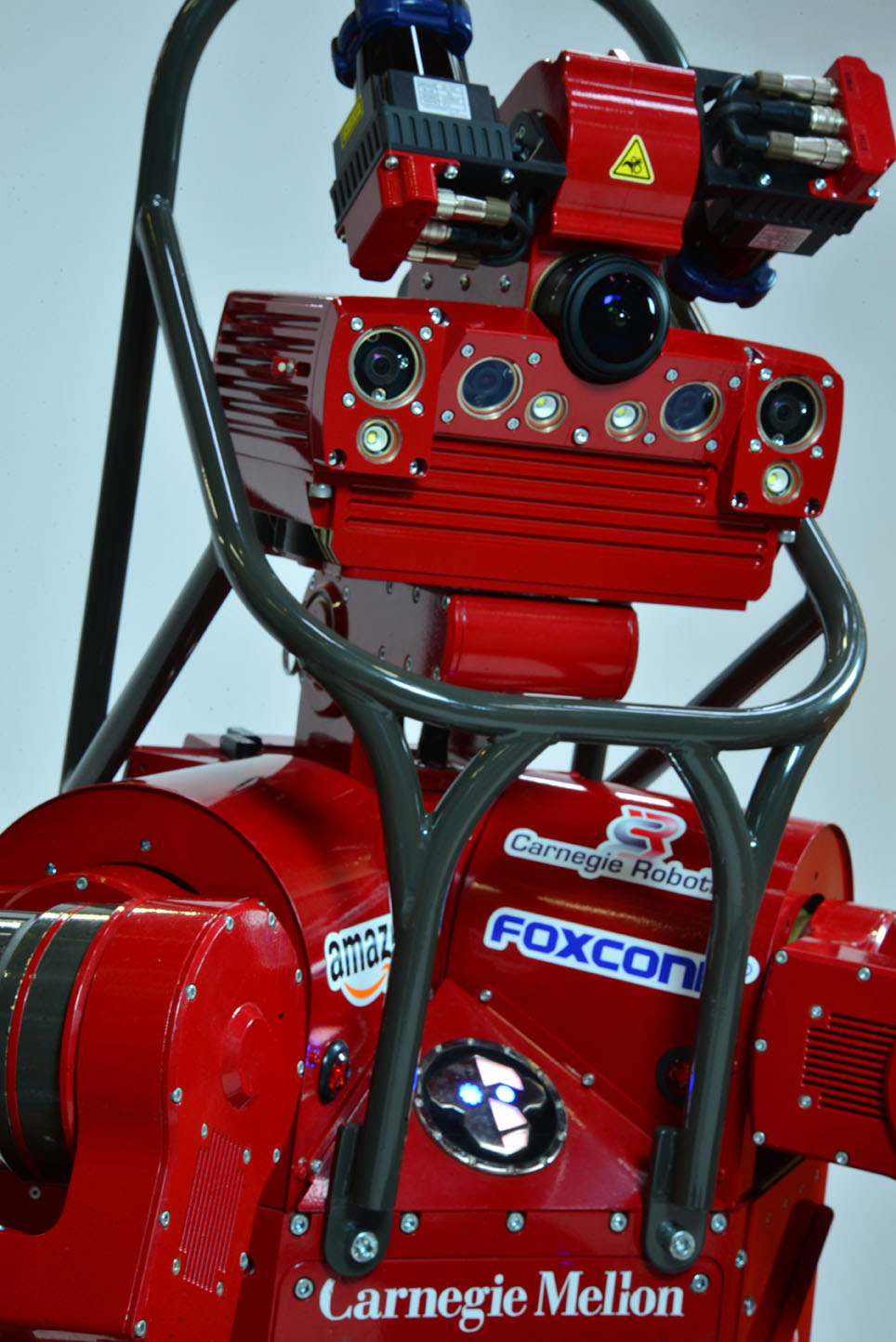Carnegie Mellon's CHIMP Robot Prepares for DARPA Robotics Challenge Finals June 5–6 National Robotics Engineering Center Team Building Up Speed on Tasks
Byron SpiceTuesday, May 26, 2015Print this page.

"Faster" is the byword for the Tartan Rescue Team from Carnegie Mellon University's National Robotics Engineering Center (NREC) as it makes final preparations for the DARPA Robotics Challenge (DRC) Finals June 5–6.
The team's four-limbed robot, CHIMP, is capable of performing all eight tasks, including driving a vehicle, climbing stairs and using power tools, that it will encounter in a simulated disaster course the Defense Advanced Research Projects Agency is assembling at the Fairplex in Pomona, Calif. But it will need to complete all tasks within the one-hour run time if it is to win the $2 million first prize.
"We realize there are a lot of great teams in this competition and the final scoring could be close," said Tony Stentz, a CMU research professor of robotics and leader of the Tartan Rescue Team. "We are making steady progress, but we can't afford to get comfortable."
The team was less comfortable prior to the DRC Trials in December 2013. Assembly of CHIMP — the CMU Highly Intelligent Mobile Platform — had been completed only a few scant weeks before the trials began. Though the team had developed the robot's software in parallel with the hardware, crucial software for several locomotion tasks, such as driving a vehicle, climbing stairs and crossing uneven terrain, didn't exist, making it impossible to even attempt those tasks at the trials.
But manipulation software, developed with the help of a surrogate robot arm prior to the robot's final assembly, enabled CHIMP to perform well on manipulation tasks and to finish in third place at the trials.
Since then, a core team of about a dozen NREC technical staff members have filled in the gaps in CHIMP's software so the robot can attempt every task in the finals. The team's latest focus has been completing all the tasks successfully within the one-hour time limit.
"We've also done quite a bit to improve reliability," Stentz said. "If one step of a task is failing, we can quickly go back and repeat it. And we have improved the software tools available to our operators, so they better understand what's happening and are less likely to make errors."
Live streaming video of the DRC Finals, 8 a.m. to 6 p.m. PDT June 5-6, is being provided by The Curiosity Project.
CHIMP is roughly the size of a human, an inch short of 5 feet when it's standing and almost 3 feet when it's crawling. It weighs 443 pounds. CHIMP's arms are 4.3 feet long — long enough to reach the ground, which is useful and gives the robot a simian-like stance. It can operate for 90 minutes or more with its battery pack.
Unlike many of its humanoid competitors that walk, CHIMP rolls on tank-like treads attached to each limb. It gets down on all fours to cross uneven terrain, but can stand on its rear legs when it must use its forelimbs for operating power tools, opening doors or other manipulation tasks.
"We designed a robot that's not going to fall down," said Clark Haynes, software lead for Tartan Rescue. Unlike walking humanoids that must actively maintain their balance, CHIMP is statically stable and won't tumble if it loses power or has a computer glitch. That promises to be an advantage at the DRC Finals, where all robots will operate without a safety harness to keep them from falling.
Other CHIMP features:
- Laser rangefinders are used to build a 3-D model of the robot's immediate environment, while cameras provide color and texture for the models. This model can be rotated and viewed from any angle, giving remote operators a 360-degree view similar to a video game. Operators can view video from the robot, but routinely use the 3-D model for most functions.
- CHIMP's unique electric drive joints give the robot tremendous power — it can curl up to 300 pounds — while also providing precise control. "From the waist up, CHIMP is a humanoid robot, and a pretty good one," Stentz said.
- Though human operators tell CHIMP what to do and show it where things are, the robot can recognize objects such as power tools and can figure out on its own how to pick them up and how to move into position. Though human operators can control CHIMP's movements, shifting many of those decisions from the humans to the robot has increased the team's speed.
NREC is part of Carnegie Mellon's Robotics Institute. It performs advanced applied research and develops prototypes for a variety of corporate and government sponsors. More than 60 NREC staff members, CMU faculty members and student interns have been involved in CHIMP's development. For more information about the Tartan Rescue Team, visit its website.
The team's sponsors include Amazon, Foxconn and Carnegie Robotics. For a full list of sponsors, please visit the team's sponsor webpage.
In addition to the Tartan Rescue Team, Carnegie Mellon faculty and students have also partnered with counterparts at Worcester Polytechnic Institute to form Team WPI-CMU, which is competing at the DRC with an Atlas humanoid robot provided to the team by DARPA.
Byron Spice | 412-268-9068 | bspice@cs.cmu.edu
